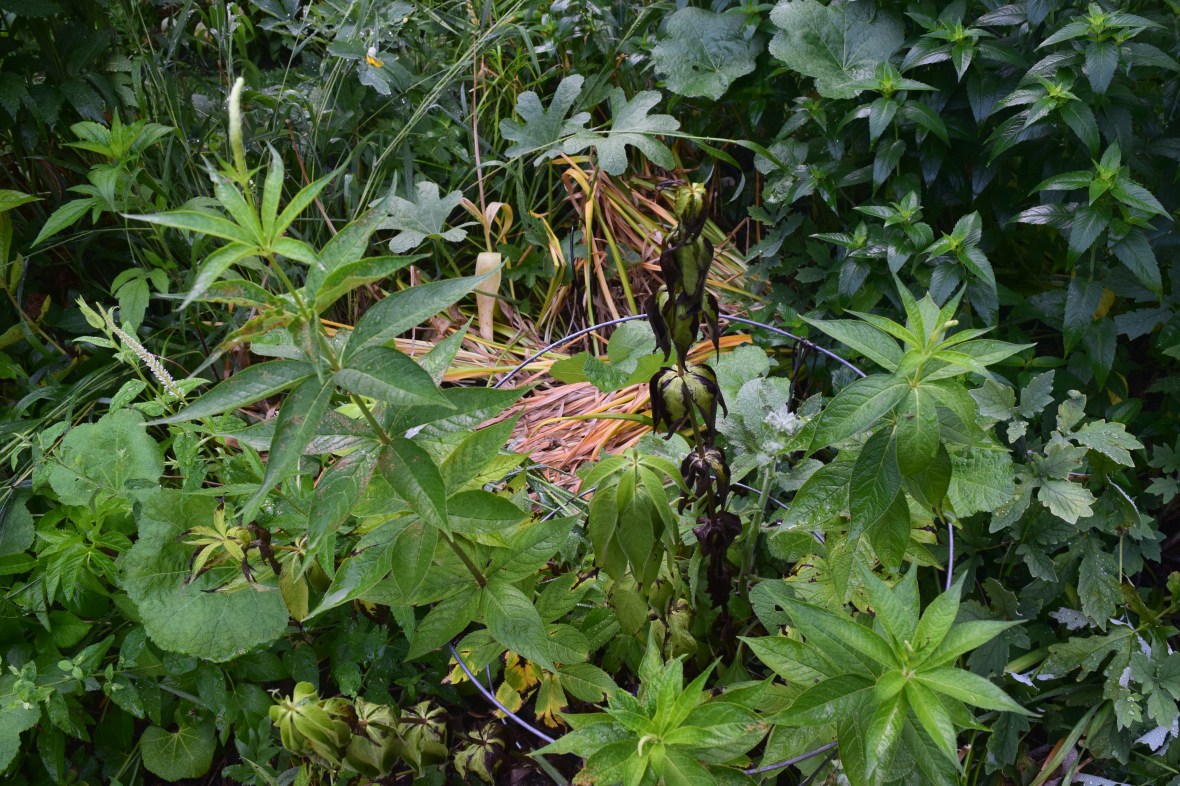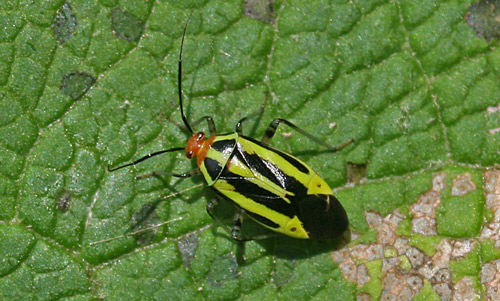There’s a hole at one end of the Driveway Border that I had expected to be full of colorful flowers by now. But it was not to be.

A number of plants have been harmed by Four-Lined Plant Bugs (FLPB) this year, none more so than the Culver’s Root (Veronicastrum virginucum). Here’s how the Culver’s Root was looking a month ago.

And here’s all that’s left of it right now. Terrible picture, but the single dying stem is circled in blue. You get the idea.

By way of contrast, here’s how the Culver’s Root looked on a good year.

The FLPB is on the verge of wiping out the Culver’s Root, but it also has damaged some other plants, notably the Anise Hyssop (Agastache foeniculum). However, it does look like we will still get some bloom this year from the Anise Hyssop. In an earlier year, the FLPB killed my patch of Calamint (Calamintha nepetoides).
My general approach is to forego all pesticides, but these critters are trying my patience.

My Milkweeds are blooming very sparsely this year. The picture above is all I’ve gotten so far out of the Common Milkweed (Asclepias syriaca) in the Sidewalk Border. The Butterflyweed (A. tuberosa) in the Driveway Border is the same story (though there is a decent patch of bloom on the other side of the driveway).
Something causes most of the Milkweed flower buds to wither before they open. The Swamp Milkweed (A. incarnata) hasn’t begun to bloom yet but I’m keeping an eye on it.
Another disappointment: this spring I planted some Russian Hollyhock (Alcea rugosa) and Fig-Leaved Hollyhock (A. ficifolia). I thought they would bloom this year but it appears I was wrong. There are plenty of leaves, but no flower stalks. Seems I’ll have to wait for next year.
Are you missing any expected blooms in your garden this year?






I’ve seen the milkweeds here blooming well, including swamp milkweeds. Culver’s root is also doing well, even though we’ve had a lot of hot, dry weather.
I don’t recognize those hollyhocks but many are biennial, which means seeing only foliage the first year would make sense.
Good luck with the insects. Hand picking in the morning maybe?
They’re tricky buggers to catch – much harder than Japanese beetles.
Yes, I am. Annuals didn’t seem to have done well. I noticed last week that there are hardly any cosmos or zinnias even though I had lots of seeds. I have a long growing season, so ordered more seeds. My perennials seem okay. I have blazing star for the first time (bulbs planted in Feb.) and they have done extremely well. Purple, pinker purple, and white.
Is your blazing star Liatris spicata? I didn’t realize that it can be propagated from corms as well as from seed. I’ve only known people who’ve grown it from seed. Very interesting!
I miss Cosmos. Also Cleome. Why haven’t I been planting them lately. I tried planting some Liatris this spring but they didn’t take.
Butterfly milkweed bloomed fine here in SW Ohio, but I’ve not seen a single butterfly of any kind yet this year. It’s disturbing.
There have been a few butterflies here, but not all that many.
My sympathies! And, yes, disappointments here. I think it’s that kind of year.
It’s a good argument for growing lots of different plants, then the odds are that something will always look good.
Every hollyhock I am familiar with are biennials. They will be gorgeous next year. I have never heard of your bad bug. It is pretty but terribly destructive. What a disappointment about your Culver’s Root etc.
My concern in the garden this year is the lack of rain. Oh sure we had a surplus late winter now we are considered unusually dry. It is a drought in my opinion. Bah humbug.
It’s been dry around here lately but not too bad yet. We are expecting rain tomorrow and Saturday.
No question, it’s been a strange gardening year so far. Things rotted in the excessively wet, lengthy spring, and now (I agree with Lisa) it’s a drought, at least in western Maryland. Things are drying up and croaking! No experience w/FLPB (yet). I have the same milkweeds as you and had the same occurrences. The veronicastrum bloomed well, but is now shriveled up. Added to these aggravations, I got a number of bags of contaminated compost this spring, which is wreaking havoc in the raised beds, decorative containers, and seedlings when they were moved up to 4″ pots. Sigh… As Margaret Roach would say, I’m ready to “throw in the trowel”!!
It’s interesting that I’ve seen very little of our green milkweed this year. Of course, I’ve not been out and about so much, so that could be the reason. What I’m most sad about is that my favorite cactus, that always has bloomed all summer long, hasn’t put on a single bud. I think it’s because I’ve moved, and it isn’t getting enough sun. Plus, there’s one squirrel that enjoys running up and down on it, and I think it probably has damaged the top.
Oh dear! All the milkweed I grew from seed have withered. Same with meadow rue and numerous other plants. I put it down to my battle with bindweed, but perhaps it is something else. My home-grown tithonia is doing very well in my backyard but friends to whom I gave seedlings have been disappointed. We live in strange times. Onward!
I finally grew Mexican Sunflowers this year from seed, and they just sit there. They are maybe 8″ tall. It’s like they are frozen in time.
Epiphyllums! We got two medium red flowers on one plant, but nothing more from the rest.
Interesting about the four-lined plant bug. I think I may have seen it at times, but not in great numbers. Most of my gardening problems are because of rabbits (they eat my milkweed, too, so all milkweed has to be fenced or in tall pots). Although I have to say that the milkweed beetles have been bad this year. They ate quite a bit of my swamp milkweed before the monarchs showed up. A few wouldn’t be a problem, but their numbers were out of control. Things seem to be balancing out now, somewhat, with lots of monarchs laying eggs.
Always heartbreaking when something prevents flowers from blooming. I have a big bunch of daylilies that have no blooms. Too much chipmunk burrowing beneath them, I think.
The hollyhocks must have been seedlings from this year, and as they are biennial they will flower next summer. Maybe there are some nematodes that would help with that beetle? I have used them against other beetles in the past, with relative success.
I’ve never used nematodes. Suppose I should look into it.
So I looked it up and it is a native bug. So sorry to see what it is doing to your garden! Please don’t zap it with chemicals though. You’ve probably tried tapping them into a cup with soapy water? That would reduce the population at least.
Purple culver’s root? I’ve never seen it other than white before. Very pretty. My milkweeds are not blooming this year and out in the field they look about like that, too. Must be something going on with all of them.
It’s actually a cultivar of Culver’s Root called ‘Fascination’.
Ah, that makes sense. How do the butterflies and bees respond to it? I quite like the cultivars of purple coneflower, but pollinators aren’t impressed by them.
They seem to like it just fine. It’s not one of those cultivars that makes changes to the basic shape of the flower or anything like that.
Oh, no, how sad. Would Culver’s Root come back next year, or is gone for good?
That rather striking bug is a real menace. Here in Seattle we had a mild winter, wet spring and rather cool summer so far, and my garden is more lush than usual. I will not complain even when rabbits are feasting on my Gazania flowers.
I’ve had that bug doing real damage for about the last four years. I’m about ready to give up on the Culver’s Root.
Blossoms in my yard seem erratic, although the common milkweed looks great. Sad about your Culver’s Root; I’d like to plant that sometime. Hollyhocks are biennials, aren’t they? The ones I grow are, at any rate, and the Japanese beetles love them. From my experience, they sometimes reseed themselves.
The species of Hollyhocks I got are supposed to be more long-lived, also more resistant to rust. We’ll see.
Sorry to see that. The Veronicastrum is a beauty.
Here dreading the arrival of the Chili Thrips, which will destroy all rose flowers for the next three months.
😦
The Chili Thrips sounds as if it could be a band.
That is a wicked beast, I am glad we do not get it over here. Amelia
I hope it stays away from your garden.
I’ve had a rather large patch of native Culver’s Root for several years. For the first time this summer several of them have turned black, just as in your picture. I was thinking it was Culver’s Root borer (Papaipema Sciata), but now I wonder if it’s FLPB’s. I also have an Asiatic lily planted near them which has something wrong—its flowers are misformed and it doesn’t have as many leaves as usual. Like you, I do not want to use pesticides. Maybe it’s time to get out there with a bowl of soapy water.
It’s worth a try. Too late for my Culver’s Root, though, at least for this year.
It really is frustrating when pest decimate plants. I won’t use pesticides but as you say at times you can be sorely tempted. I have problems with lily beetle, rosemary beetle and an endless invasion of green and black fly.xxx
Happily I haven’t had to deal with any of those.
Most of my common milkweed looks great this year, though the smaller ones have yellowing growth at the top (I think from drought?). But I have some serious regrets about planting common milkweed: should have planted a different kind. It’s wandering into my lawn and neighbor’s yard (sorry neighbors). I bought some showy milkweed this year; hopefully I’ll be able to distinguish the two and continue the removal of the common but still have snacks for the monarchs.
I also had problems with the echinacea starting to bloom and then drying up crispy brown. I’ve never seen that happen before. Most of them are fine though.
All my echincea was ruined by aster yellows years ago. Yes, the common milkweed spreads like crazy. I’m always mowing it down in the lawn now.
Hello Jason, I find it difficult to “fess-up” when things go wrong, but I had a whole load of gladiolus byzantinus bulbs planted last autumn that performed very poorly, I think the soil is too dry for them. I’ve also tried for years to establish dierama (one of my favourite flowers) and it has just weakly flowered this year. The worst is that the Banksiae finally outcompeted and saw off the japanese wisteria that was growing along with it. To be fair, I had my suspicions about the condition of the graft of the wisteria right from the start, but this spring, it finally failed and the whole plant died. It never flowered otherwise that loss would be truly heartbreaking.
I can’t imagine wisteria being outcompeted by anything, but maybe I am not familiar with Japanese wisteria.